
I entered Kyoto Marathon thinking it must be a major event. I didn’t realise that it is only in its fifth year, and judging by the lack of Namban Rengo entries, not yet one of the must-do races. Still, I was happy to be doing a race in this iconic city, even if the race is not yet iconic. Kyoto also has the advantage of being attractive to my wife, so for once Miki accompanied me to a race and cheered me on at the very moment when I need cheering – the 35-kilometre slump. I got through that slump and completed the race in a better time than my final 7 kilometres would have suggested. It also gave me the new vague hope that I might be able to go under 3 hours one day, on a fast downhill course with the wind behind me.
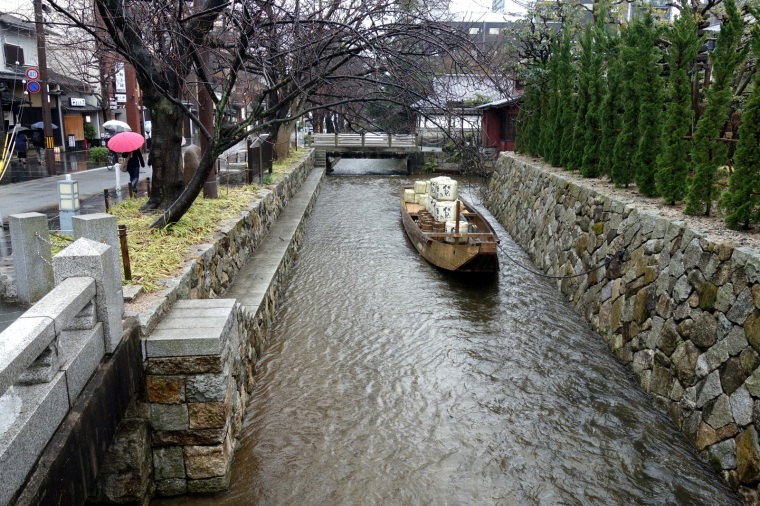 Tasegawa Canal
Tasegawa Canal
We took the shinkansen from Shin-Yokohama and less than two hours later arrived in the city I had found so disappointing 22 years ago when I had travelled there with my family. Back then, I had imagined an ancient city perched on a hill, narrow streets winding between ancient buildings. Instead I felt like I had gone round in a circle and was mysteriously back in Tokyo. This time I was well prepared for the typically modern, identikit Japanese city, and spent my time focusing on the glimpses of beauty and style that hint at what Kyoto once might have been. As we walked from the subway station along Takasegawa Canal to our hotel, I quickly realised I had been a bit too harsh 22 years ago. The area is full of interest and atmosphere, and as we later discovered, delicious food and drink.
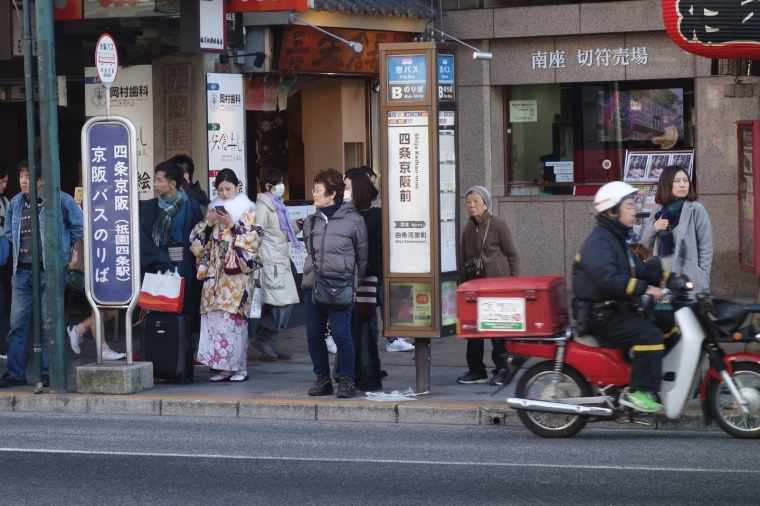
Our curiously named hotel, Gran Ms Kyoto, was just a glorified business hotel, but it was in a perfect location for the race – a short train ride to the start, and a long walk from the finish. One street over, through the grounds of a temple, is the covered shopping street Teramachi which connects with several similar arcades. Nearby on Gokomachi-dori we found two excellent restaurants, Ouchi Italian Miyuki-cho Shokudo – a name which might benefit from abbreviation – and just over the road a serious soba place. We had a coffee in the stylish Café Independents which is in the basement of a former newspaper works.

Registration for the race was in Miyako Messe, a large hall near Heian Shrine. Getting there was easy, but escaping from the expo proved much more difficult as I was forced to shuffle along through crowds of people sipping energy drink testers and trying on discount running shoes. Still, the registration process was quick thanks to the fact that I was the only person using the foreign runners check-in. I managed a corny joke about my race number, 40039….four hundred thank you.
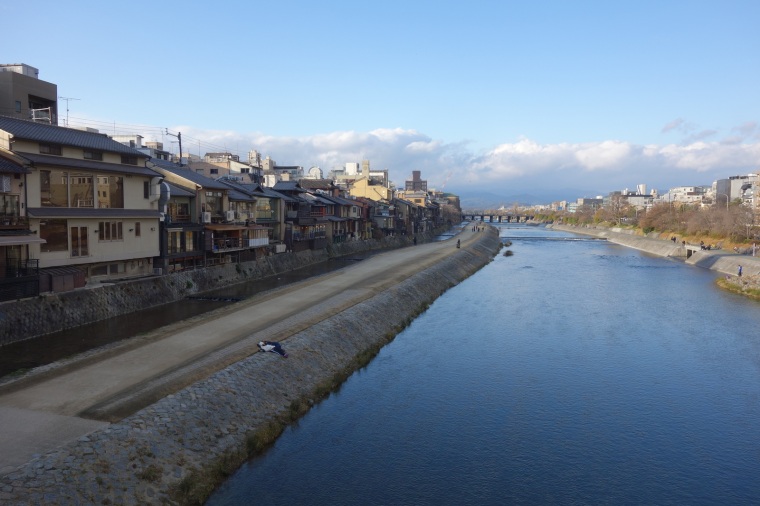 The race went along the banks of the Kamogawa River
The race went along the banks of the Kamogawa River
The weather had promised to be cold and clear on race day, but at the last minute it changed to a warm 8 degrees with some clouds. I took the train to Nishi-Kyogoku station and joined the tide of athletic-looking people moving towards the athletics stadium from which we would start our long run. It turned out to be a great start venue as there are several stadia there as well as a gymnasium and other buildings. There were numerous toilets, so if you looked hard it was possible to avoid the impossibly long lines that plague every race. While most people shivered outside in the morning chill, I spent as long as possible sitting in the spectators seating in the gymnasium, feeling nice and warm. At the last minute, I checked in my bag and made my way to my Block A for the start. In Tokyo, I had been in Block E which had made for a very slow start. Block A was a different kettle of fish. On the gun, everyone sped off and drew me along at a grand speed. Too grand, in fact, as I maintained a sub-4:30 pace all the way until the 30 km mark. My plan has been to go for a 4:30 pace, but I felt so good running amongst all these fast people that I got rather carried away. I wondered if I could sustain this 4:22 to 4:25 pace all the way to the finish.
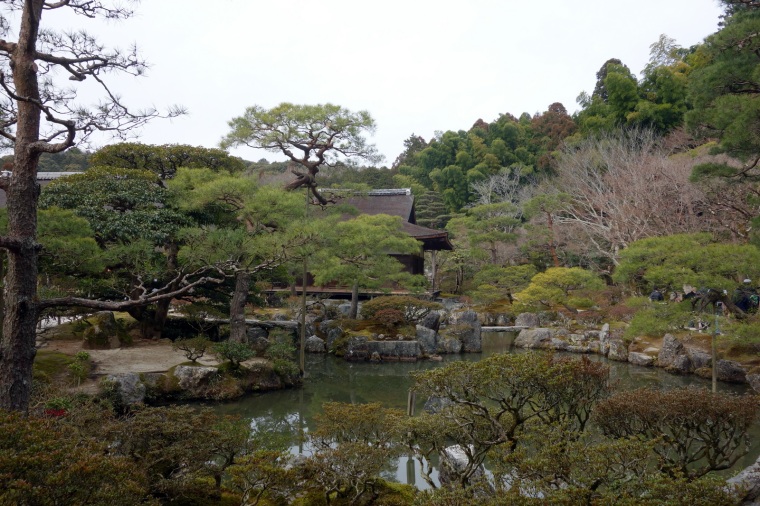 The race passed in front of Ginkaku-ji
The race passed in front of Ginkaku-ji
I found the course wonderful. We headed west to the Katsura river, then north along its banks before turning north east along the edge of Kyoto’s northern foothills. From time to time there would be a volunteer standing with a sign pointing at an ancient bridge or temple or the giant 大 above us on the hillside. I tried to take in every sight as I knew this might be a once-in-a-lifetime experience. 42 kilometres of condensed, high energy sightseeing in one of the world’s great historic cities. The foothills added two challenges to the race. The first and most obvious challenge was the numerous gentle slopes we faced. They would have been gentle to fresh legs, but with my legs tiring, each slope seemed steeper than the one before. In total, we climbed 217 metres in the race, which doesn’t sound much, but it felt like an awful lot at the time. This compares with 49 metres for Tokyo Marathon. Apart from the hills, there was also a fresh northerly wind sweeping down from the mountains. This meant the first 18 kilometres were mostly into a headwind. At the 18-kilometre mark we crossed a bridge over the Kamogawa river and from then on felt the wind at our backs until the dreaded 35-kilometre mark in front of the City Hall.
The course was great, but the support was even better. Crowds lined the route from start to finish. Young and old – lots of old people – drummers and dancers, singers and shouters. I was pushed along on a wave of support. Wearing my Namban Rengo shirt helped as so many people shouted out “gambatte namban rengo!” It also brought a smile to people’s lips, perhaps due to the curious nature of the name. There were numerous taiko drum groups, but one stood out – a huge troop of women belting away at giant drums, shouting and cheering us on. Just past the 25 km mark the course entered the Botanical Gardens where a line of 4 white-faced maiko were playing music. We then entered a long stretch along the banks of the Kamogawa river, much of it on hard-packed dirt – a great relief to weary thighs and calves.
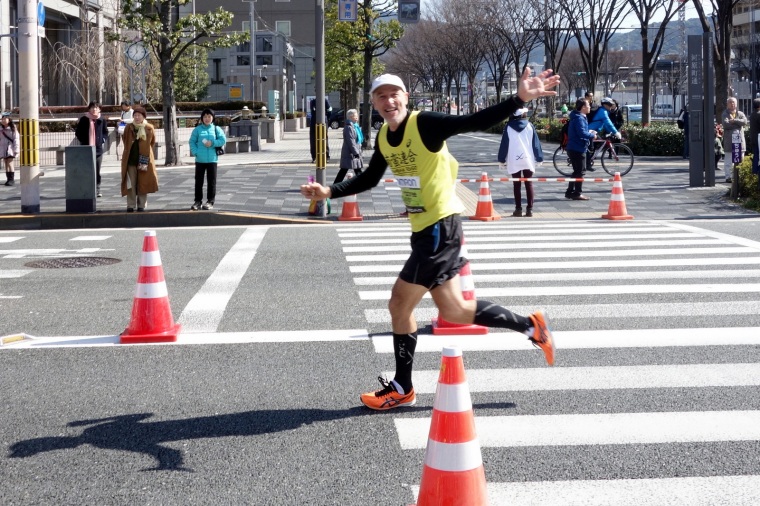 In front of Kyoto City Hall, 7 km to go
In front of Kyoto City Hall, 7 km to go
The last part of the race is on city streets with several sections requiring us to run up one side of the road and back down the other. It felt like I was getting nowhere. Each kilometre was slower than the one before, and I kept feeling the onset of cramp. I passed several runners keeled over at the side of the road, concerned officials and medics crouched over them. Some must have been very fast on a good day, but marathon is a great leveller. We never know when our body is going to shut down. At 38 km I started feeling faint and realised I was low on sugar. I sucked on the last half a gel and soon felt better. Surprisingly I managed to find a deeply buried reserve of energy and finished the last two kilometres at a faster pace. I reached the line completely spent, not even knowing I had finished until I realised there was nowhere else to run. Dazed, drained and absolutely delighted.
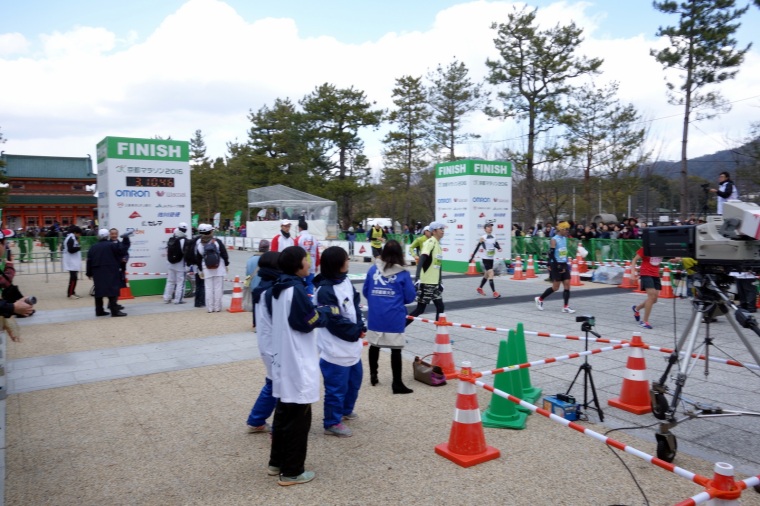
I picked up my bag, had a limp massage, and then went in search of Miki. Remarkably, I bumped straight into her and we headed off in search of lunch. I wanted to keep my legs moving so we walked back to Takasegawa Canal where we found the excellent Tadg McLoughlin’s Irish Bar. Huge salads, great craft beer.
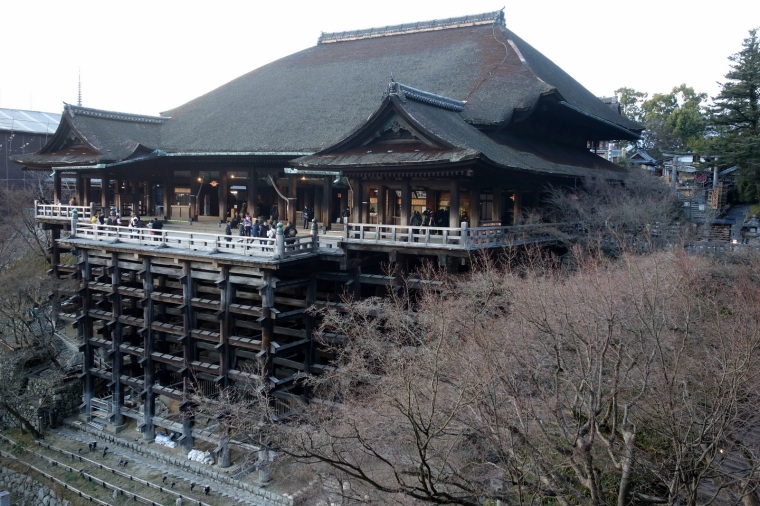 The awe-inspiring Kiyomizu-dera
The awe-inspiring Kiyomizu-dera
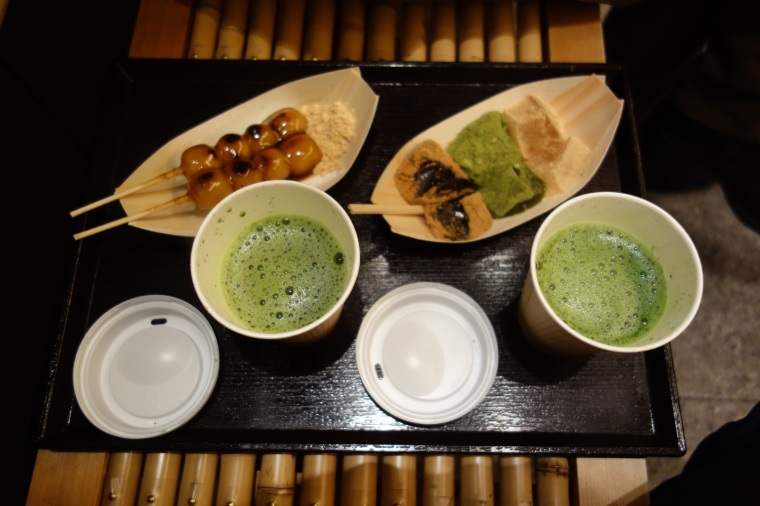 Macha and dango
Macha and dango
We spent the rest of the afternoon walking around Kiyomizu-dera and Gion. It was fantastic walking up – very much up – the narrow streets lined with perfectly preserved wooden buildings. The Higashi-yama area has changed much since my last visit. It is now alive with young tourists, many of them Chinese, and many dressed in kimonos. A lot of the local businesses are adapting: signs are in several languages, coffee shops are all around, and we even found a fast food green tea and dango shop, packed with kimono wearing Chinese youths. We stayed till dark and then walked along the gently lit streets of Gion. It was all very magical but somewhat strange to be there a few hours after running the marathon.
Higashi-yama
Next day, we were up bright and early for some serious sightseeing. We walked all around Nanzenji, which reminded us of Kita-Kamakura, along the Philosopher’s Walk, and then around the wonderful Ginkakuji. On the way, we dropped in at a simple noodle restaurant behind a craft shop but were surprised to find everything homemade, natural and vegetarian. The soup stock was made from shiitake, rather than fish, and the owner was clearly proud of her healthy creations.
 Philosopher’s Walk
Philosopher’s Walk
Finally, we headed for Kyoto Station. We had a bit of time, so we took the long escalators up to the roof for a final look across the city. Next to the escalators there is a wide flight of steps embedded with thousands of tiny lights. As people walked down the steps their silhouetted bodies turned into black animations moving through the lights. It seemed such a contrast to the ancient sights we had spent the day walking around, but all the better for it.
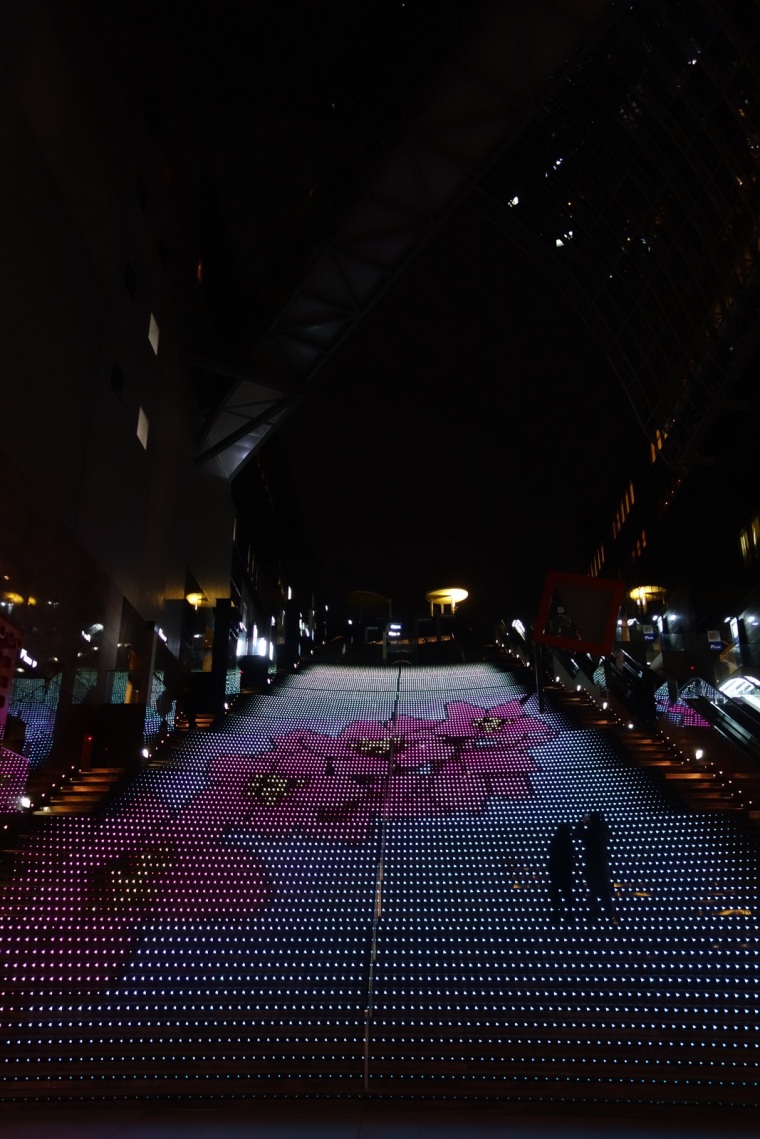 Kyoto Station
Kyoto Station



